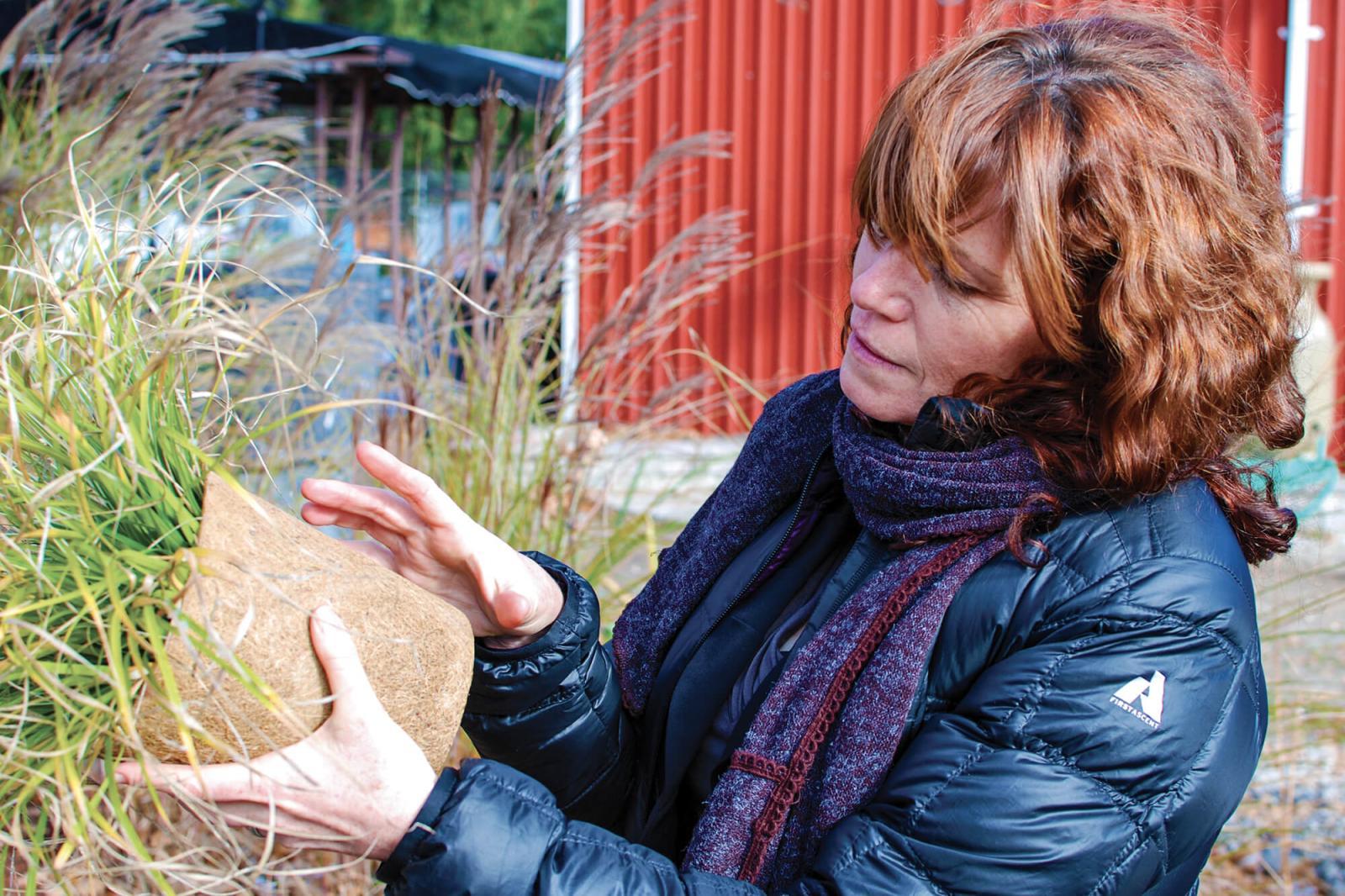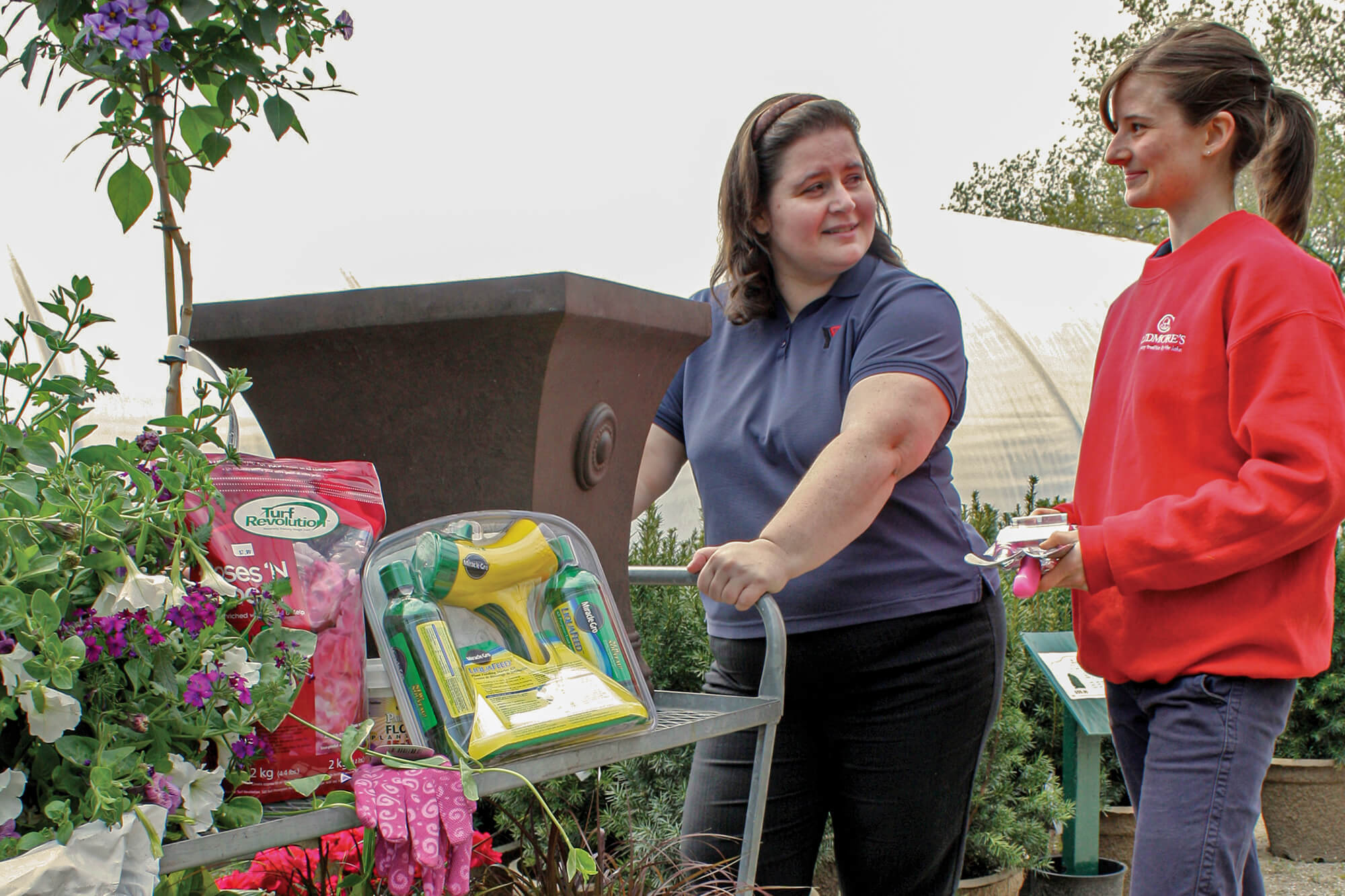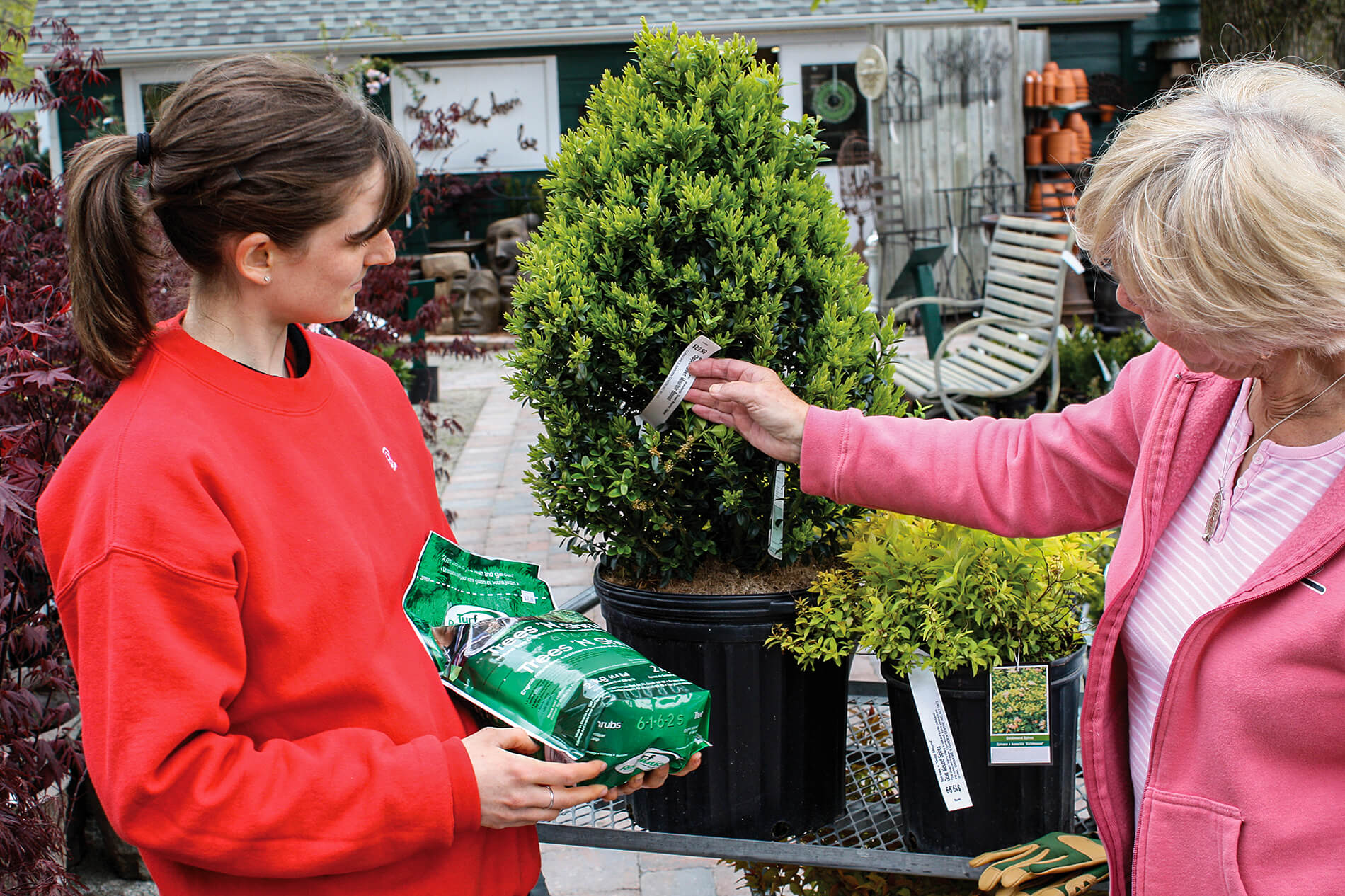December 15, 2014

Women are looking for products that will be good for their families and good for the planet. This plant was grown in a coconut coir pot instead of a traditional plastic pot. The coir pot can even be planted with the ornamental grass, the coir pot is completely compostable. Good point-of-purchase information can help get this message across.
What women want
Understand your customer, and how to sell her green living
Every garden centre retailer knows that the major consumer group for ornamental plants are females, between the ages of 35 and 55 years old. Yet very few have taken the time to understand what she is really looking for and what her decision-making process is for her purchasing style.
There was a brilliant film, What Women Want, which came out in 2000, starring Mel Gibson. If you haven’t seen this movie, you really should. In the film Mel’s character can hear women’s thoughts and the experience gives him incredible insight and understanding of the female mind.
It probably wouldn’t surprise you to know that the purchasing style of this female consumer is not a very streamlined process, nor is it predictable or, dare I say, necessarily practical. Perhaps it’s more accurate to say that it’s not a man’s type of practical.
We know what we want when we see it
I am a woman in the 35 to 55 age group, which includes several of my girlfriends and sisters. If you asked us what we wanted and why, I bet there would be times when we wouldn’t be able to tell you in a language that anyone outside the age and gender group could understand. We may not always know what we want before we go shopping, but Baby, we sure know it when we see ‘it’!Navigating female relationships is tricky business, even for me. Of the long-term female friendships I’ve had, I would have to say that I’ve been in the dog house a lot. And most of the time, I didn’t even know why. Sound familiar? On top of that, I’m raising a ‘tween’ daughter, so I know what’s coming for me. Recently I have re-married and my sweet husband tells me that one of things he really likes about me is that I quite often think like a man. Uh-oh.
So one of my girlfriends told me about this great book she had read, it’s called The Female Brain by Louann Brizendine. Once I saw the cover — a telephone cord all tangled up in a big knot — I knew this was the book for me. The author uses medical science, psychology and humour to explain why females think the way they do. And she does it really well.
Brizendine states that male brains are typically nine per cent larger than female brains, even when you take into account the difference in body size. The cool thing is that both male and female brains have the same number of cells; the female brain cells are just packed in more tightly together. Now that explains a lot already, doesn’t it?
Brizendine explains that female and male brains are pretty much guided by, you guessed it, hormones. The hormones that are the biggest drivers in the aforementioned female consumer age group are estrogen, progesterone and oxytocin, as well as others. These hormones bathe female brains and direct behaviour and values like connection, communication and nurturing. The male brain is also guided by hormones, but these are testosterone, vasopressin and MIS (Mullerian inhibiting substance). These hormones bathe the male brain and direct behaviour and values such as physical activity, aggression, protection and social hierarchy.
Brizendine goes on to say that the part of the brain largely responsible for emotion and memory, the hippocampus, is actually larger in the female brain. That means that in addition to memorizing every detail of that argument we had with you eight years and 2.56 months ago, both positive and negative shopping experiences can stay with us for a long time.
Women have deep connections with other women in friendships and find a lot of satisfaction in these relationships. I’d have to say that my girlfriends and I spend at least one-third of our time referring each other to products and services that we and our loved ones have benefited from. Being able to pass on this information to each other feels really good to us.
I started giving you advice in the first paragraph! I’m sure women in this age group are significantly responsible for referrals in retail, both good and bad.
 Many women shop when they want to celebrate something. They shop when they need to lift their spirits. In the ornamental plant industry, you have the right kind of product to accomplish that.
Many women shop when they want to celebrate something. They shop when they need to lift their spirits. In the ornamental plant industry, you have the right kind of product to accomplish that.
Three distinct groups
Within this female consumer age group, there are three distinctive groups. The first is those still involved in child-rearing. Their mommy brains are geared for their children’s well-being, development, education and safety. They are coping with increased work stress and perhaps a little maternal guilt. These women have an incredible attachment to their children and have made a significant emotional investment in their families, thanks to the hormone oxytocin.These women are looking for products that will be good for their families and good for the planet. They want products that will enhance their children’s enjoyment of the outdoors, but they want child-friendly oriented products. They are interested in instant vegetable gardens and small shrubs and trees that will bear fruit that is delicious and nutritious for their family (e.g. Haskap berries or the Romance series of dwarf cherry trees).
These consumers are more likely to purchase children’s gardening accessories and child-based gardening projects like home-made stepping stones and participate in fun workshops for children. Having sales staff that can entertain and somewhat occupy young children can be a wonderful boost for your business and give mommy a little more time to shop.
The second group is made up of those women in the middle. These middle-aged ladies are still very focused on family, but their own health and well-being are becoming increasingly important. These women are learning to make time for themselves without the 24-7 pressures of raising young children. They buy products for themselves that are attractive and give them a boost, at a fair price or a decent volume discount.
When they purchase a plant, they want to know where it comes from and the factoids on what it’s used for medicinally and nutritionally. They want to know that they are doing a good thing. And, they want to bestow all of this wisdom onto their girlfriends. These women will pay a little more for something, but only if it means that it will help give their house some curb appeal, help the planet or a charitable organization, or significantly reduce their workload when they get home (e.g. finished designer planters).
This savvy female consumer is current on environmental issues. Provide her plants in well-signed containers that are made from coconut coir, corn or biocomposites (plant based materials combined with recycled plastics) that are compostable. I remember receiving a sample of biodegradable coir pots years ago for some research I was doing. Some of the ladies in the mail room came over and actually gave me a pat on the back and smiles of approval.
The third group is the 50-somethings. These women have a very big interest in staying healthy, improving their well-being and embracing new challenges. So what’s on the brain of these female consumers? Many are still quite focused on their families, but career, community and the environment play a very important role as well.
They are planning for retirement and looking to make home improvements to increase market value. Gardening personality Carson Arthur says that landscaping and outdoor rooms have replaced kitchen and bathroom as the number one way to improve the resale value of our homes.
Focus on home improvements
Since Scotiabank has gone on record to say that 50 per cent of Canadians plan to sell their homes in the next five years, home improvement statistics for landscaping should flow off your staff’s tongues like melted butter.How about this: Carson Arthur says that for every dollar you invest in landscaping, the return is actually $2 or more, especially as the landscape becomes more established. The return on kitchens and bathroom upgrades is actually more like $0.60 for every dollar spent And this: the addition of a shade trees and some landscaping along with some minor home improvements can boost buyer traffic and the resale house value by as much as 17 per cent (Elam and Stigarll, Journal of Environmental Horticulture, December, 2012). What it really comes down to is that shopping can be a very emotional experience for women. Picking out plants for some of us is along the same lines as picking out a puppy or a kitten. And yes, some of us have to look at every single one before we decide which one we are going to take home. So, give us the space to do it.
Female consumers become stressed with over-attentive sales people. That part of our brain that registers emotional kind of stress registers strongly and locks away in our long-term memory. That means that the stress of the extra sales attention can be enough for us to leave the store before buying anything, even if we found something we really liked. And, we will never return.
A sincere, “Hello, let me know if I can help you,” with eye contact and a smile, is a great way to welcome your customer and make you look accessible without being pushy.
Know emotional triggers
So knowing that women have these emotional triggers, what can retailers do to cash in? Make your retail experience welcoming and hire (how shall I put this?) experienced sales staff that are very professional, personable and good at reading social cues. Provide simple, attractive tags or signs that provide educational factoids, something like “when this tree is mature it will sequester enough carbon to offset the carbon dioxide emissions of driving your vehicle 2,200 km”. Or how about “one large tree can provide a day’s supply of oxygen for four people” (North Carolina State University). Inspire them with demonstration gardens like Canadale Nurseries does. Give a value-added experience by providing take home “how-to” information and provide accessories like supplies for canning their own fruits and veggies. Provide after-hours workshops for “make your own” health and beauty products, basil pesto and salsa and turn it into a private party with some light refreshments and music. Several retailers are already doing this with wreath-making and holiday urn workshops for consumers and found it to be quite worthwhile to the business.Inspire them with demonstration gardens as found at Canadale Nurseries in St. Thomas. Give a value-added experience by providing take home how-to information and provide accessories like supplies for canning their own fruits and veggies. Provide after-hours workshops for make your own health and beauty products, basil pesto and salsa and turn it into a private party with some light refreshments and music. Several retailers are already doing this with wreath-making and holiday urn workshops for consumers. They have found it to be quite worthwhile.
It probably wouldn’t surprise you to know that many women view shopping as a pleasurable experience. They shop when they want to celebrate something. They shop when they need to lift their spirits. In the ornamental plant industry, you have the right kind of product to accomplish that, now why not create a retail space that lets those female customers hang out and stay a while with some light refreshments and a comfortable sitting area? What if you added a TV with gardening shows and magazines on the table?
Men and women often have two very distinctively different styles of shopping. Most men go in a store to buy socks and come out with a pair of socks. Women go in a store to buy socks and they find three pairs like the ones that are made out of a renewable resource such as bamboo. Then, there are the other thoughtful items they bought for themselves and their loved ones.
 Provide simple, attractive tags or signs that provide educational factoids, something like “when this tree is mature it will sequester enough carbon to offset the carbon dioxide emissions of driving your vehicle 2,200 km.”
Provide simple, attractive tags or signs that provide educational factoids, something like “when this tree is mature it will sequester enough carbon to offset the carbon dioxide emissions of driving your vehicle 2,200 km.”
Women enjoy shopping
Men usually have a short list of what they need and don’t mind paying a little more if they only have to go to one store. Women know at least some of the items that they need, but those items need to match certain emotional criteria and they don’t mind searching for a bargain. Many, many women enjoy shopping and they don’t mind shopping around for the best price and value.This is what sets your female consumer apart from males. I know a certain lady who deliberately leaves the original price tag on gifts, accidentally. Every time I unwrap a present from her, I get the same sheepish smile with an, “Oh did I do that?” This is followed by a long gushing description of how many stores she had to go to and how much it was marked down. A lot of women are hard core bargain hunters.
If you look around at the Costco warehouse, it’s the men pushing the carts as they follow their female partners scanning all of the items and subconsciously going through her emotional checklist, while evaluating volume discounts. But the men keep coming. Why is that? Simple: the perception of good quality at a decent price. There are no sales at Costco.
It’s a well-known fact that many men will pay more for a brand name than women. This is where Costco delivers. The members-only aspect is also attractive to a lot of men. Costco has a lot of display items that are manly, like big screen TVs and electronics. Ever notice that these are the first items you encounter when you walk in their store? Costco parking is usually easy to access (except for weekends), customer service is very good and their checkout lines move relatively quickly, even when they are busy. And at the end, there is inexpensive food and a lounge area.
Clothing retailers have bought into this a little, providing manly lounge areas near dressing rooms and stocking men’s magazines, or even a TV. Retailers know that if they can just keep the men occupied, the women will be able to go off and do some unencumbered impulse shopping without being nagged.
Influence women shoppers
Women enjoy shopping for plants more than men. Look around most garden centres and you will see the vast majority of customers are women. If you aren’t in a position to attract more of their male companions, what can you do to influence your female customers to buy more or more often?A woman might bring her male partner to the garden centre, because they can’t stand to be away from each other. Or, a woman might bring her male partner because she needs his help to get the items into the vehicle and home. Have staff available in clearly-labelled company clothing near check-out and exit. Many retail centres have super-friendly staff who will offer to help carry out items and load them in the customer’s vehicle. Having a home-delivery and landscape service is also very attractive to this group of female consumers.
There’s something else you can do for your female consumer: talk to them. Have someone very personable, maybe who isn’t the owner or an employee, engage some of your customers in conversation. Ask them what they like and what they think they would like to see in addition to the products and services you provide. But ask them while you are doing something for them, while you are making them a complimentary snack or loading purchases into their vehicle. Show them that you genuinely care, but be sure to take only a few minutes of their time.
To help improve your understanding of your main consumer group and the women in your life, I highly recommend reading The Female Brain. For those of you wondering if Brizendine has written about the male brain, good news, she has. After several requests she did write The Male Brain. I must say, it was an interesting and entertaining read. Now of course the running joke is that if she wrote a book about the male brain, it would be a lot shorter than The Female Brain. So I was genuinely surprised to receive my copy and find out that The Male Brain book was almost as thick as The Female Brain book. But do you know what? Half the pages in The Male Brain are notes and references.
Jen Llewellyn is a Nursery Crops Specialist with the Ontario Ministry of Agriculture and Food.